Study of the Evolution Characteristics of Microseismic Events during the Excavation of Underground Caverns under High Geostress
Abstract
1. Introduction
2. Project Overview
2.1. Project Background
2.2. Geological Structure and Geostress
3. Evolution Characteristics of MS Events during the Excavation of the Underground Powerhouse under High Geostress
3.1. Construction of the MS Monitoring System
3.2. Temporal Distribution Characteristics of MS Events
3.3. Spatial Distribution Characteristics of MS Events
3.4. Analysis of MS Evolutionary Responses to Construction Dynamics
4. FLAC-Based 3D Numerical Modeling
4.1. Numerical Model
4.2. Calculation Results
5. Conclusions
- An MS monitoring system was built during the excavation of the underground powerhouse at the Shuangjiangkou hydropower station. The temporal distribution pattern of the MS events was obtained during the excavation of benches I and II of the underground powerhouse from 19 July 2018 to 31 October 2020. The study reveals that MS events occurred frequently during the excavation of bench I, with an average of more than nine events in a single day. Moreover, the MS events still appeared during the support period when the blasting was stopped, indicating that the surrounding rock experienced a long stress adjustment under high geostress. However, the MS events occurred less frequently overall during the excavation of bench II due to the stress release and minor disturbance from the blasting, with an average of less than five events in a single day. The spatial distribution pattern of the MS events indicates that the high ground stress environment usually had a large number of MS events. There were three concentration zones of MS events with large energy and high moment magnitude, which are closely related to the construction dynamics and planes of geological structures.
- The intensive blasting and construction periods from 19 July 2018 to 3 December 2018 were selected to examine the dynamic relationship between the evolution of the MS events, the site construction conditions, and the geological structures. In summary, site blasting construction was the main factor inducing MS events in and around underground caverns under high geostress. The distribution of the MS events were strongly correlated with the location of the site blasting. Moreover, the frequency of the MS events was positively correlated with that of the blasting. The number of MS events was increased by the structural plane. The possibility of the surrounding rock becoming unstable was raised by the structural plane.
- The simulated maximum cross-sectional displacement of each turbine generally appeared near the spandrel during the excavation of the underground powerhouse for bench I. The maximum displacement occurred in the vicinity of the lamprophyre dyke near the upstream spandrel. The numerical modeling results closely matched the MS monitoring data and the site failure status of the rock mass. The failure and deformation of the rock mass were greatly impacted by the geological structure of the underground powerhouse under high geostress.
Author Contributions
Funding
Institutional Review Board Statement
Data Availability Statement
Acknowledgments
Conflicts of Interest
References
- Song, S.W.; Feng, X.M.; Xiang, B.Y.; Xing, W.B.; Zeng, Y. Research on key technologies of high and steep rock slope engineering of southwest hydropower. J. Rock Mech. Geotech. Eng. 2011, 30, 1–22. [Google Scholar]
- Zhu, W.H.; Li, Y.; Li, S.C.; Wang, S.G.; Zhang, Q.B. Quasi-three-dimensional physical model tests on a cavern complex under high in-situ stresses. Int. J. Rock. Mech. Min. Sci. 2011, 48, 199–209. [Google Scholar]
- Li, T.B.; Liu, T.Y.; Chen, G.Q.; Ma, C.C.; Zhang, H. Construction of microseismic monitoring system for highway tunnels and analysis of microseismic characteristics. Chin. J. Undergr. Space. Eng. 2019, 15, 1188–1196. [Google Scholar]
- Young, R.; Collins, D.; Reyes-Montes, J.; Baker, C. Quantification and interpretation of seismicity. Int. J. Rock Mech. Min. Sci. 2004, 41, 1317–1327. [Google Scholar] [CrossRef]
- Hassani, H.; Hloušek, F.; Alexandrakis, C.; Buske, S. Migration-based microseismic event location in the Schlema-Alberoda mining area. Int. J. Rock Mech. Min. Sci. 2018, 110, 161–167. [Google Scholar] [CrossRef]
- Barthwal, H.; Calixto, F.J.; van der Baan, M. 3-D attenuation tomography from microseismicity in a mine. Geophys. J. Int. 2019, 219, 1805–1817. [Google Scholar] [CrossRef]
- Young, R.; Collins, D. Seismic studies of rock fracture at the Underground Research Laboratory, Canada. Int. J. Rock Mech. Min. Sci. 2001, 38, 787–799. [Google Scholar] [CrossRef]
- Krietsch, H.; Gischig, V.; Evans, K.; Doetsch, J.; Dutler, N.O.; Valley, B.; Amann, F. Stress Measurements for an in situ stimulation experiment in crystalline rock: Integration of induced seismicity, stress relief and hydraulic methods. Rock Mech. Rock Eng. 2019, 52, 517–542. [Google Scholar] [CrossRef]
- Denlinger, R.P.; Bufe, C.G. Reservoir conditions related to induced seismicity at the Geysers steam reservoir, northern California. Bull. Seism. Soc. Am. 1982, 72, 1317–1327. [Google Scholar] [CrossRef]
- Rutledge, J.T.; Phillips, W.S. Hydraulic stimulation of natural fractures as revealed by induced microearthquakes, Carthage Cotton Valley gas field, east Texas. Geophysics 2003, 68, 441–452. [Google Scholar] [CrossRef]
- Zhao, Q.; Lisjak, A.; Mahabadi, O.; Liu, Q.; Grasselli, G. Numerical simulation of hydraulic fracturing and associated microseismicity using finite-discrete element method. J. Rock Mech. Geotech. Eng. 2014, 6, 574–581. [Google Scholar] [CrossRef]
- Akono, A.; Druhan, J.L.; Dávila, G.; Tsotsis, T.; Jessen, K.; Fuchs, S.; Crandall, D.; Shi, Z.; Dalton, L.; Tkach, M.K.; et al. A review of geochemical–mechanical impacts in geological carbon storage reservoirs. Greenh. Gases: Sci. Technol. 2019, 9, 474–504. [Google Scholar] [CrossRef]
- Li, S.Y.; He, X.S.; Zhang, S.Q.; Lu, Q.H.; Jiang, X.Q.; Tong, X.H.; Li, T.; Guan, E.F.; Zuo, Y.; Sun, X.H.; et al. Progress and latest achievements of mine seismic monitoring technology. Prog Geophys. 2004, 19, 853–859. [Google Scholar]
- Tang, L.Z.; Jian, Y.H.; Li, D.Y.; Deng, L.F.; Chen, Y. Analysis on failure mechanism of surrounding rock of mine based on microseismic moment tensor. Rock Soil Mech. 2017, 38, 1436–1444. [Google Scholar]
- Dou, L.M.; Feng, L.F.; Cai, W.; Wang, H.; He, H.H.; Jiao, B.; Zhang, M. Study on acoustic earthquake precursor recognition and comprehensive early warning model in coal and rock disaster damage process. J. Min. Saf. Eng. 2020, 37, 10. [Google Scholar]
- Zhu, Q.J.; Jiang, F.X.; Wei, Q.D.; Wang, B.; Liu, J.H.; Liu, X.H. Automatic pickup method of P-wave first break of microseismic signal of coal seam hydraulic fracturing. J. Rock Mech. Geotech. Eng. 2018, 37, 2319–2333. [Google Scholar]
- Jiang, L.; Kong, P.; Zhang, P.; Shu, J.; Wang, Q.; Chen, L.; Wu, Q. Dynamic Analysis of the Rock Burst Potential of a Longwall Panel Intersecting with a Fault. Rock Mech. Rock Eng. 2020, 53, 1737–1754. [Google Scholar] [CrossRef]
- Chen, B.R.; Feng, X.T.; Zeng, X.H.; Xiao, Y.X.; Zhang, Z.T.; Ming, H.J.; Feng, G.L. Real time monitoring and characteristic analysis of microseisms in TBM tunneling of deep tunnels. J. Rock Mech. Geotech. Eng. 2011, 30, 275–283. [Google Scholar]
- Feng, G.-L.; Feng, X.-T.; Chen, B.-R.; Xiao, Y.-X.; Zhao, Z.-N. Effects of structural planes on the microseismicity associated with rockburst development processes in deep tunnels of the Jinping-II Hydropower Station, China. Tunn. Undergr. Space Technol. 2019, 84, 273–280. [Google Scholar] [CrossRef]
- Liu, X.; Tang, C.; Li, L.; Lv, P.; Sun, R. Microseismic monitoring and stability analysis of the right bank slope at Dagangshan hydropower station after the initial impoundment. Int. J. Rock Mech. Min. Sci. 2018, 108, 128–141. [Google Scholar] [CrossRef]
- Liang, Z.; Xue, R.; Xu, N.; Dong, L.; Zhang, Y. Analysis on microseismic characteristics and stability of the access tunnel in the main powerhouse, Shuangjiangkou hydropower station, under high in situ stress. Bull. Eng. Geol. Environ. 2020, 79, 3231–3244. [Google Scholar] [CrossRef]
- Xue, R.; Liang, Z.; Xu, N.; Dong, L. Rockburst prediction and stability analysis of the access tunnel in the main powerhouse of a hydropower station based on microseismic monitoring. Int. J. Rock Mech. Min. Sci. 2020, 0126, 104174. [Google Scholar] [CrossRef]
- Dai, F.; Li, B.; Xu, N.; Fan, Y.; Zhang, C. Deformation forecasting and stability analysis of large-scale underground powerhouse caverns from microseismic monitoring. Int. J. Rock Mech. Min. Sci. 2016, 86, 269–281. [Google Scholar] [CrossRef]
- Dai, F.; Li, B.; Xu, N.; Meng, G.; Wu, J.; Fan, Y. Microseismic Monitoring of the Left Bank Slope at the Baihetan Hydropower Station, China. Rock Mech. Rock Eng. 2017, 50, 225–232. [Google Scholar] [CrossRef]
- Li, B.; Xu, N.; Dai, F.; Zhang, G.; Xiao, P. Dynamic analysis of rock mass deformation in large underground caverns considering microseismic data. Int. J. Rock Mech. Min. Sci. 2019, 122, 104078. [Google Scholar] [CrossRef]
- Li, B.; Ding, Q.-F.; Xu, N.-W.; Dai, F.; Xu, Y.; Qu, H.-L. Characteristics of microseismic b-value associated with rock mass large deformation in underground powerhouse caverns at different stress levels. J. Central South Univ. 2022, 29, 693–711. [Google Scholar] [CrossRef]
- Zhao, J.-S.; Jiang, Q.; Lu, J.-F.; Chen, B.-R.; Pei, S.-F.; Wang, Z.-L. Rock fracturing observation based on microseismic monitoring and borehole imaging: In situ investigation in a large underground cavern under high geostress. Tunn. Undergr. Space Technol. 2022, 126. [Google Scholar] [CrossRef]
- Li, B.; Ding, Q.-F.; Xu, N.-W.; Lei, Y.-F.; Xu, Y.; Zhu, Z.-P.; Liu, J.-F. Mechanical response and stability analysis of rock mass in high geostress underground powerhouse caverns subjected to excavation. J. Central South Univ. 2020, 27, 2971–2984. [Google Scholar] [CrossRef]
- Ding, Q.; Li, B.; Su, H.; Xu, N.; Li, X.; Deng, X. Damage mechanism and stability analysis of rock mass in the high geo-stress tunnel subjected to excavation. Geomatics Nat. Hazards Risk 2022, 13, 75–93. [Google Scholar] [CrossRef]
- Ka, M.; Liu, G.Y. Three-dimensional discontinuous deformation analysis of failure mechanisms and movement characteristics of slope rockfalls. Rock Mech. Rock Eng. 2022, 55, 275–296. [Google Scholar]
- Song, R.; Liu, J.; Yang, C.; Sun, S. Study on the multiphase heat and mass transfer mechanism in the dissociation of methane hydrate in reconstructed real-shape porous sediments. Energy 2002, 254. [Google Scholar] [CrossRef]
- Song, R.; Wang, Y.; Tang, Y.; Peng, J.; Liu, J.; Yang, C. 3D Printing of natural sandstone at pore scale and comparative analysis on micro-structure and single/two-phase flow properties. Energy 2022, 261. [Google Scholar] [CrossRef]
- Salari, A.; Kazemian, A.; Ma, T.; Hakkaki-Fard, A.; Peng, J. Nanofluid based photovoltaic thermal systems integrated with phase change materials: Numerical simulation and thermodynamic analysis. Energy Convers. Manag. 2022, 205, 112384. [Google Scholar] [CrossRef]
- Quarteroni, A.; Luca, F. Mathematical modelling and numerical simulation of the cardiovascular system. Handb. Numer. Anal. 2004, 12, 3–127. [Google Scholar]
- Hasheminezhad, A.; Bahadori, H. Seismic response of shallow foundations over liquefiable soils improved by deep soil mixing columns. Comput. Geotech. 2019, 110, 251–273. [Google Scholar] [CrossRef]
- Zhao, J.-S.; Chen, B.-R.; Jiang, Q.; Lu, J.-F.; Hao, X.-J.; Pei, S.-F.; Wang, F. Microseismic Monitoring of Rock Mass Fracture Response to Blasting Excavation of Large Underground Caverns Under High Geostress. Rock Mech. Rock Eng. 2022, 55, 733–750. [Google Scholar] [CrossRef]
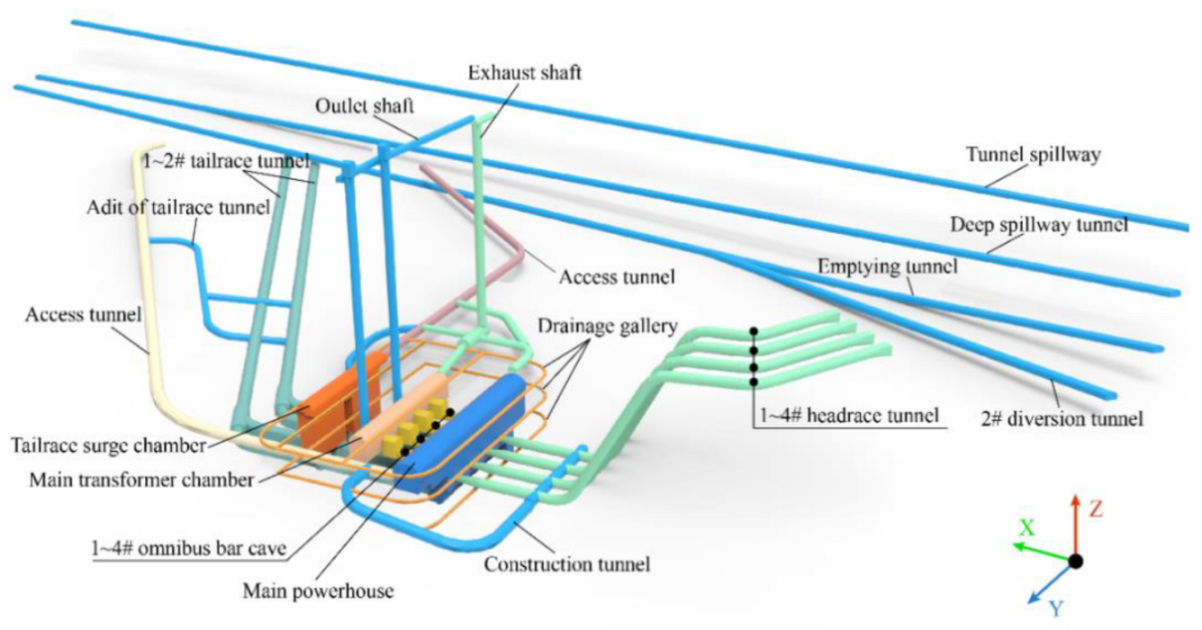
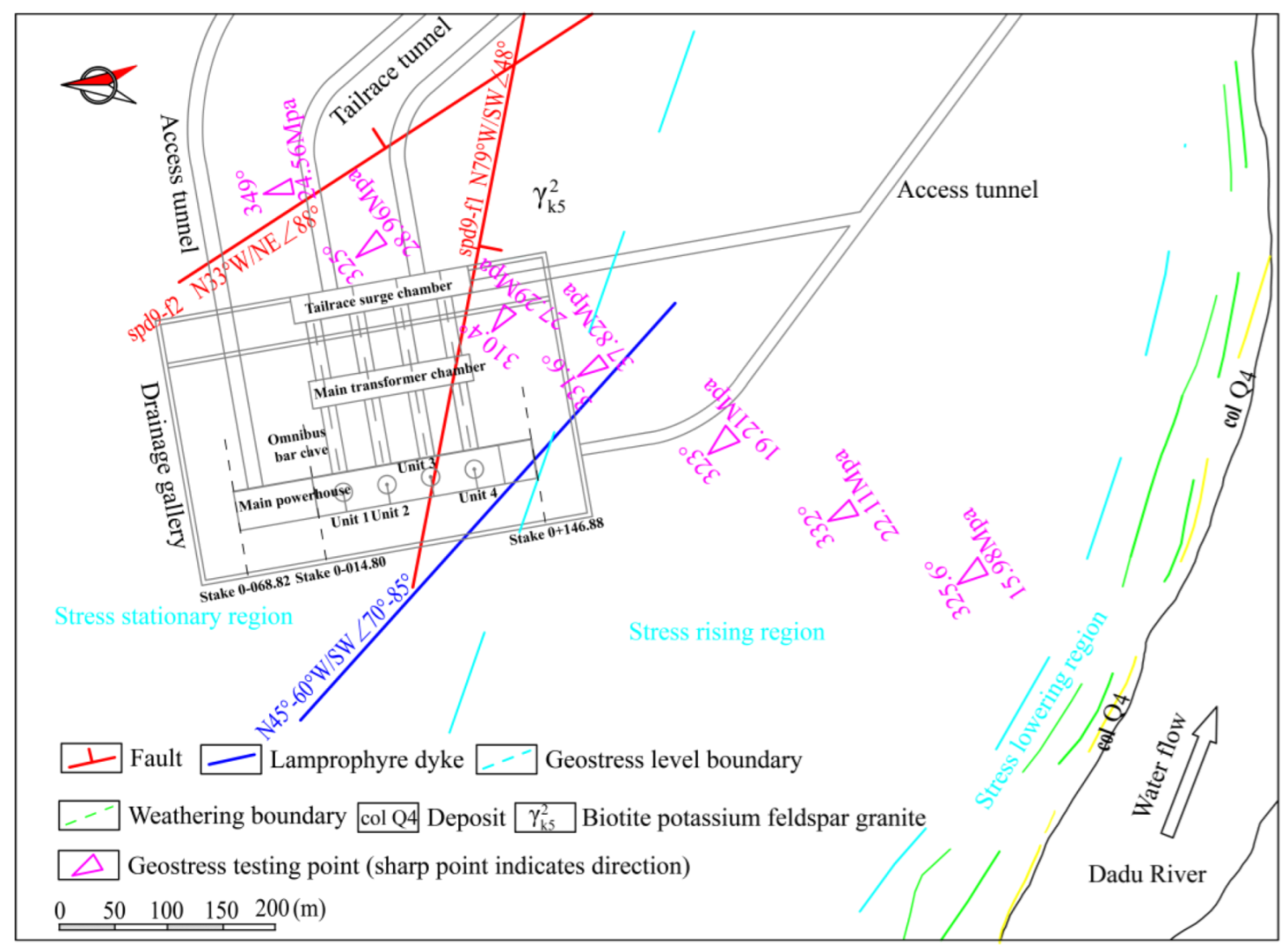

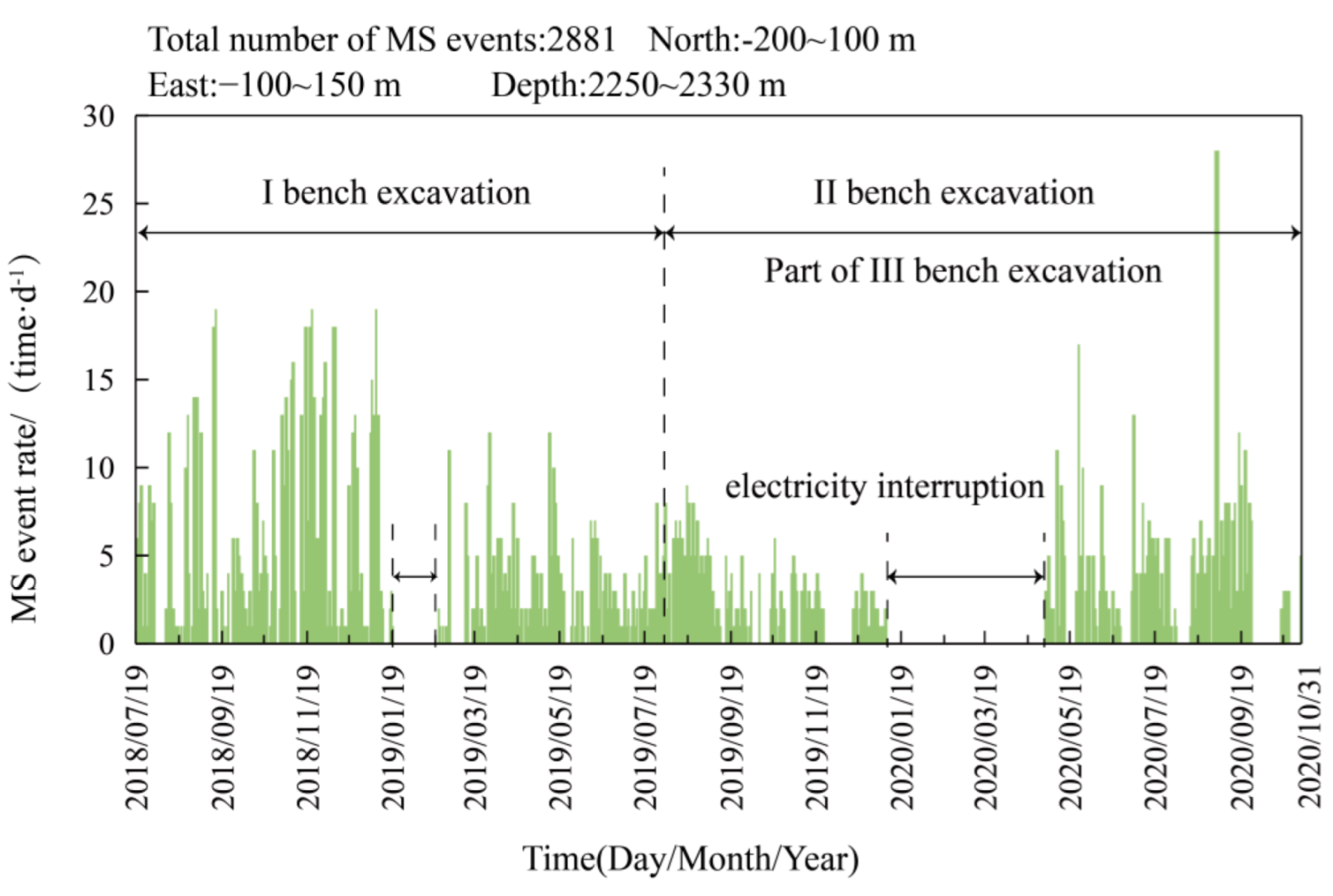


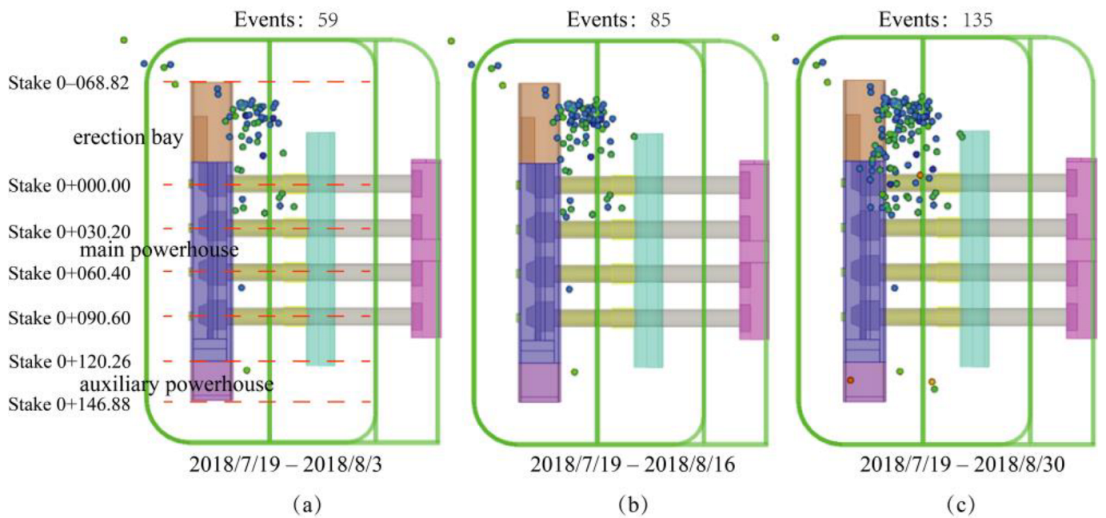
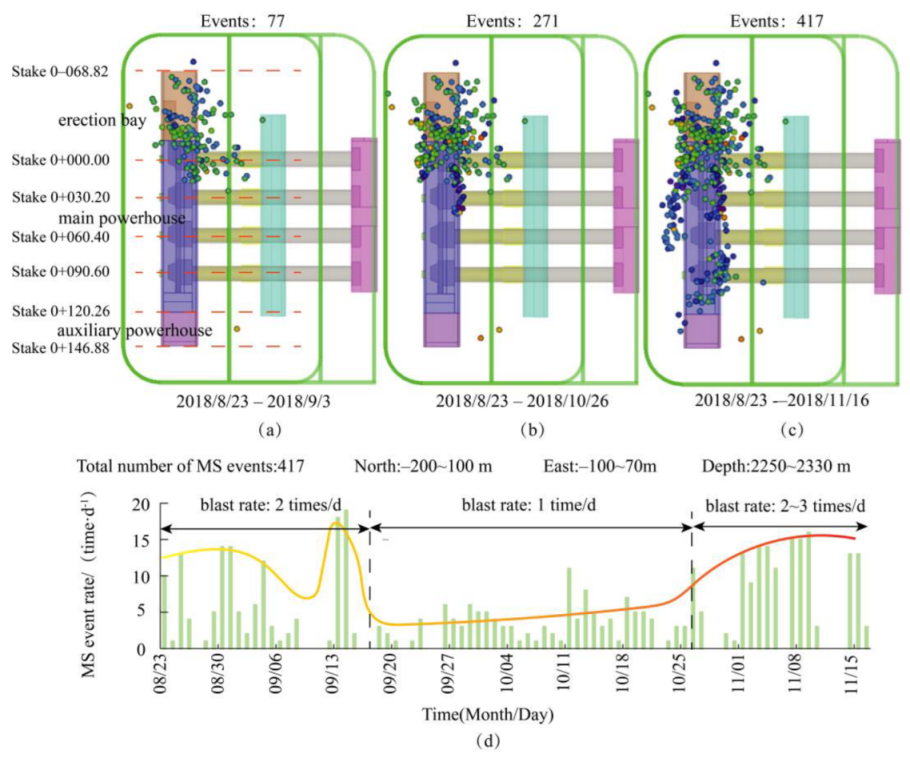
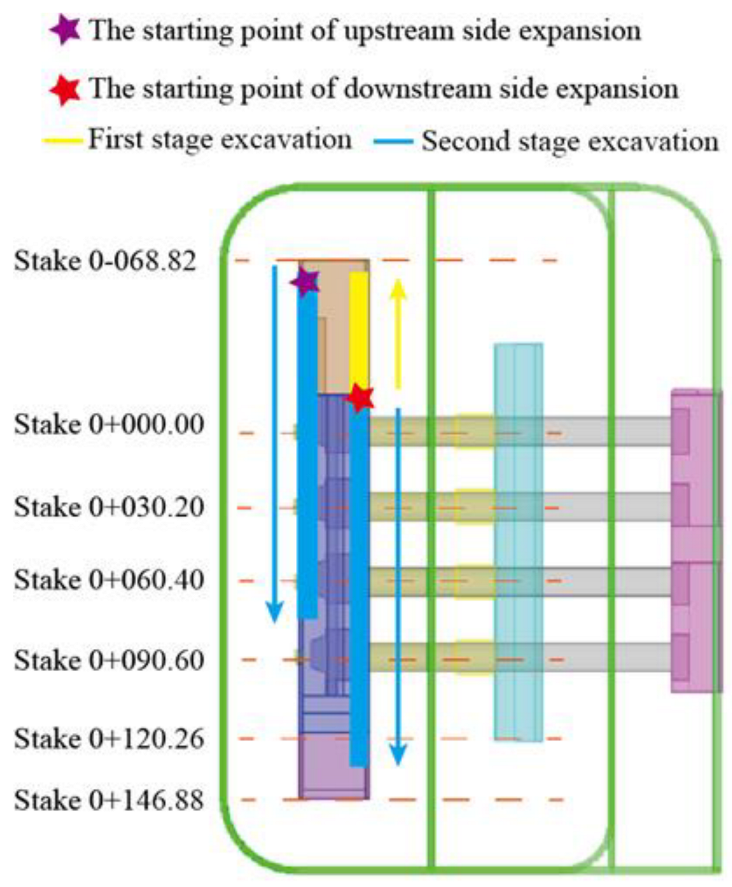


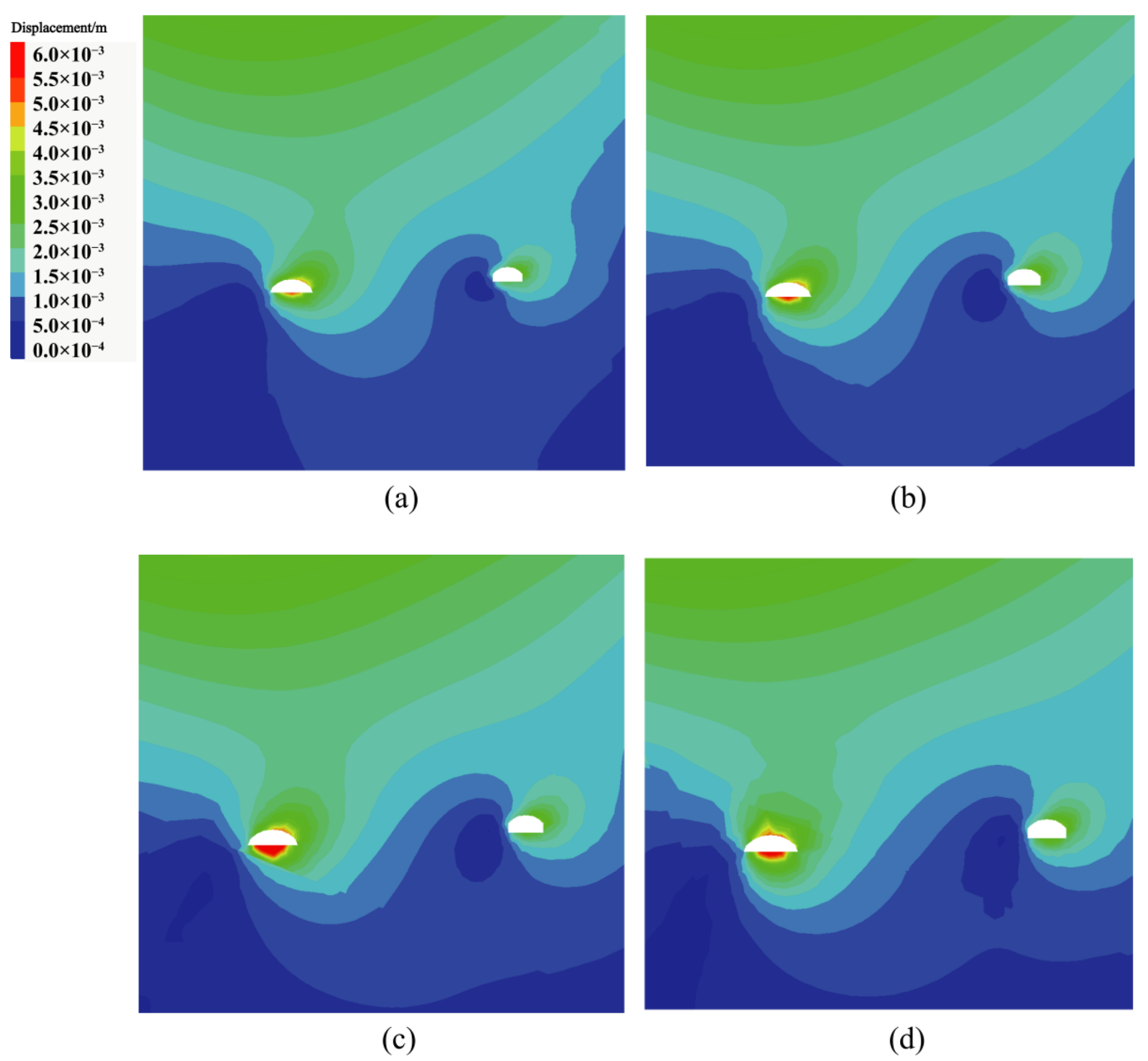
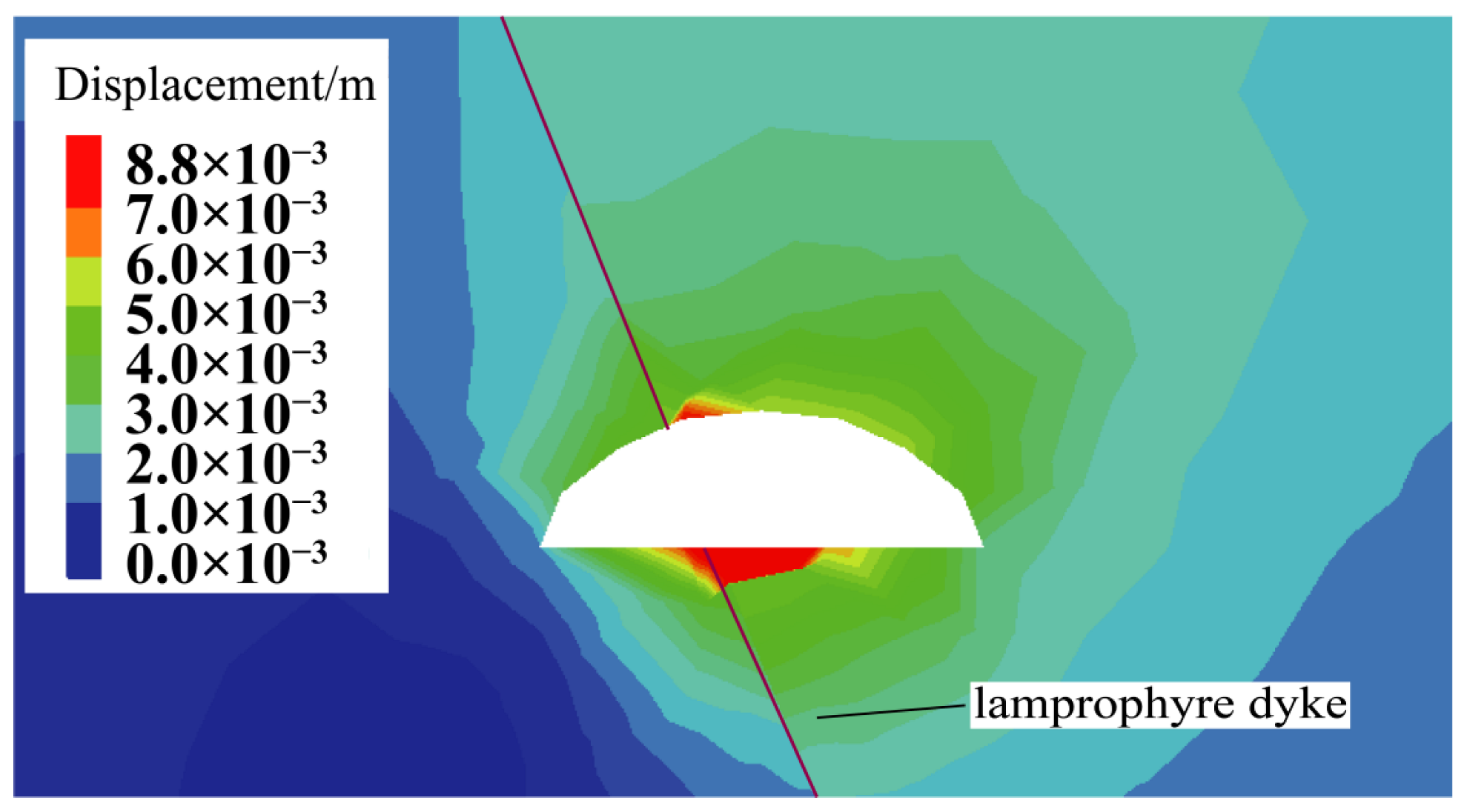
| Fault/Joint | Location Depth in the SPD9 Adit | Attitude | Fracture Zone Width | Angle of Intersection with the Plant Axis |
|---|---|---|---|---|
| SPD9-F1 | 504–505.5 m | N79°W/SW∠48° | 50–60 cm | 69° |
| SPD9-f2 | 625 m | N33°W/NE∠88° | 80–140 cm | 23° |
| Lamprophyre dyke | 380–395 m | N35°–50°W/SW∠72°–75° | 80–110 cm | 25°–40° |
| J1 | N20°–50°E/SE∠25°–42° | 30°–60° | ||
| J2 | N5°–26°E/NW∠10°–30° | 15°–36° | ||
| J3 | N50°–75°W/SW∠58°–75° | 60°–85° | ||
| J4 | N60°–80°E/NW∠5°–15° | 50°–80° | ||
| J5 | N50°–60°E/SE∠45°–65° | 40°–50° |
| Stress Classification | Maximum Principal Stress Level σm (MPa) | Rock Strength–Stress Ratio Rb/σm |
|---|---|---|
| Very high | σm ≥ 40 | <2 |
| High | 20 ≤ σm < 40 | 2–4 |
| Moderate | 10 ≤ σm < 20 | 4–7 |
| Low | σm < 10 | >7 |
| Parameter Category | Density (g/cm3) | Bulk Modulus (GPa) | Shear Modulus (GPa) | Poisson’s Ratio | Cohesion (MPa) | Internal Friction Angle (°) | Tensile Strength (MPa) |
|---|---|---|---|---|---|---|---|
| IIIa | 2.55 | 29.2 | 13.5 | 0.25 | 1.5 | 45 | 6.5 |
| Structural Plane | Normal Stiffness (GPa/m) | Shear Stiffness (GPa/m) | Cohesion (MPa) | Internal Friction Angle (°) | Tensile Strength (MPa) |
|---|---|---|---|---|---|
| SPD9-F1 | 6 | 3 | 0.05 | 20 | 0.05 |
| SPD9-F2 | 6 | 3 | 0.05 | 20 | 0.05 |
| Lamprophyre dyke | 10 | 5 | 0.1 | 25 | 0.1 |
Publisher’s Note: MDPI stays neutral with regard to jurisdictional claims in published maps and institutional affiliations. |
© 2022 by the authors. Licensee MDPI, Basel, Switzerland. This article is an open access article distributed under the terms and conditions of the Creative Commons Attribution (CC BY) license (https://creativecommons.org/licenses/by/4.0/).
Share and Cite
Lin, X.; Li, B.; Li, P.; Ding, Q.; Huang, M. Study of the Evolution Characteristics of Microseismic Events during the Excavation of Underground Caverns under High Geostress. Appl. Sci. 2022, 12, 12145. https://doi.org/10.3390/app122312145
Lin X, Li B, Li P, Ding Q, Huang M. Study of the Evolution Characteristics of Microseismic Events during the Excavation of Underground Caverns under High Geostress. Applied Sciences. 2022; 12(23):12145. https://doi.org/10.3390/app122312145
Chicago/Turabian StyleLin, Xin, Biao Li, Peng Li, Quanfu Ding, and Mengting Huang. 2022. "Study of the Evolution Characteristics of Microseismic Events during the Excavation of Underground Caverns under High Geostress" Applied Sciences 12, no. 23: 12145. https://doi.org/10.3390/app122312145
APA StyleLin, X., Li, B., Li, P., Ding, Q., & Huang, M. (2022). Study of the Evolution Characteristics of Microseismic Events during the Excavation of Underground Caverns under High Geostress. Applied Sciences, 12(23), 12145. https://doi.org/10.3390/app122312145







